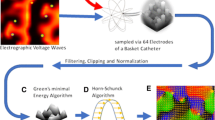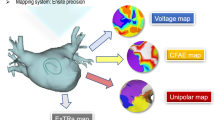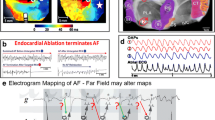Abstract
Purpose
Targeting repetitive sources identified during atrial fibrillation (focal impulse and rotor modulation, FIRM) has been used as an ablation strategy using specific mapping tools. Aim of this study was to evaluate FIRM mapped rotors with a new multipolar mapping algorithm.
Methods
Patients with persistent atrial fibrillation undergoing FIRM ablation were included. Mapping of left atrial rotors was performed with a 64-pole basket catheter in conjunction with a specialized phase mapping algorithm. Subsequently, raw signals were analyzed by a novel mapping system (CARTOFINDER™). Comparison of FIRM identified sources with areas of repetitive activation analyzed by CARTOFINDER™ was performed.
Results
Nine patients were included (5 redo procedures; male n = 6; 66.5 ± 8.6 years) and 28 left atrial rotors were compared with the findings of the novel mapping system. CARTOFINDER™ identified repetitive activation patterns in 6 mapping sequences at remote sites (2 rotational patterns, 4 linear activation patterns).
Conclusions
In this comparative preliminary study, two different mapping technologies to detect repetitive atrial activation during ongoing AF were used. Whereas rotational activation was documented using FIRM mapping no corresponding repetitive activation patterns near sites of FIRM-mapped rotor cores were identified using the novel mapping technology even though using the same electrogram characteristics and mapping basket position.




Similar content being viewed by others
References
Kirchhof P, Benussi S, Kotecha D, Ahlsson A, Atar D, Casadei B, et al. 2016 ESC guidelines for the management of atrial fibrillation developed in collaboration with EACTS. Europace. 2016;18:1609–78.
Narayan SM, Krummen DE, Shivkumar K, Clopton P, Rappel WJ, Miller JM. Conventional ablation for atrial fibrillation with or without focal impulse and rotor modulation CONRIFM. J Am Coll Cardiol. 2012;60:628–36.
Miller JM, Kowal RC, Swarup V, Daubert JP, Daoud EG, Day JD, et al. Initial independent outcomes from focal impulse and rotor modulation ablation for atrial fibrillation: multicenter FIRM registry. J Cardiovasc Electrophysiol. 2014;25:921–9.
Gianni C, Mohanty S, Di Biase L, Metz T, Trivedi C, Gökoglan Y, et al. Acute and early outcomes of focal impulse and rotor modulation (FIRM)-guided rotors-only ablation in patients with nonparoxysmal atrial fibrillation. Heart Rhythm. 2016;13:830–5.
Schade A, Halbfass P, Mueller P, Nentwich K, Roos M, Steinborn F, et al. FIRM only ablation in patients with persistent atrial fibrillation: acute and medium term results. Europace. 2015;17:iii68.
Benharash P, Buch E, Frank P, Share M, Tung R, Shivkumar K, et al. Quantitative analysis of localized sources identified by focal impulse and rotor modulation mapping in atrial fibrillation. Circ Arrhythm Electrophysiol. 2015;8:554–61.
Haissaguerre M, Hocini M, Shah AJ, Derval N, Sacher F, Jais P, et al. Noninvasive panoramic mapping of human atrial fibrillation mechanisms: a feasibility report. J Cardiovasc Electrophysiol. 2013;24:711–7.
Lee S, Sahadevan J, Khrestian CM, Cakulev I, Markowitz A, Waldo AL. Simultaneous biatrial high-density (510-512 electrodes) epicardial mapping of persistent and long-standing persistent atrial fibrillation in patients. New insights into the mechanism of its maintenance. Circulation. 2015;132:2108–17.
Yamabe H, Kanazawa H, Ito M, Kaneko S, Ogawa H. Prevalence and mechanism of rotor activation identified during atrial fibrillation by noncontact mapping: lack of evidence for a role in the maintenance of atrial fibrillation. Heart Rhythm. 2016;13:2323–30.
Mandapati R, Skanes A, Chen J, Berenfeld O, Jalife J. Stable microreentrant sources as a mechanism of atrial fibrillation in the isolated sheep heart. Circulation. 2000;101:194–9.
Baykaner T, Yoakum S, Krummen D, Narayan SM. Reduction of early recurrence of atrial fibrillation by focal impulse and rotor modulation-guided ablation J Am Coll Cardiol 2015; 10S. doi:10.1016/S0735-1097(15)60417-X.
De Groot N, van der Does L, Yaksh A, Lanters E, Teuwen C, Knops P, et al. Direct proof of endo-epicardial asynchrony of the atrial wall during atrial fibrillation in humans. Circ Arrhythm Electrophysiol. 2016; doi:10.1161/CIRCEP.115.003648.
Author information
Authors and Affiliations
Corresponding author
Ethics declarations
Conflict of interest
P. Halbfass has received an educational grant from Boston Scientific and travel grants from Biotronik and BiosenseWebster. P. Müller has received an educational grant from Boston Scientific. T. Deneke has received lecture’s honoraria from TOPERA and travel grants from Biotronik and BiosenseWebster. All other authors have not reported any financial disclosures or conflicts of interest.
Funding
No funding was received for this study.
Ethical approval
The study was approved by the local institutional review board and was carried out in accordance with The Code of Ethics of the World Medical Association (Declaration of Helsinki) for experiments involving humans.
Informed consent
All patients provided written informed consent regarding the study.
Rights and permissions
About this article
Cite this article
Halbfass, P., Müller, P., Nentwich, K. et al. Repetitive atrial activation during ongoing atrial fibrillation—comparison using different mapping algorithms: preliminary findings. J Interv Card Electrophysiol 49, 67–74 (2017). https://doi.org/10.1007/s10840-017-0244-8
Received:
Accepted:
Published:
Issue Date:
DOI: https://doi.org/10.1007/s10840-017-0244-8




